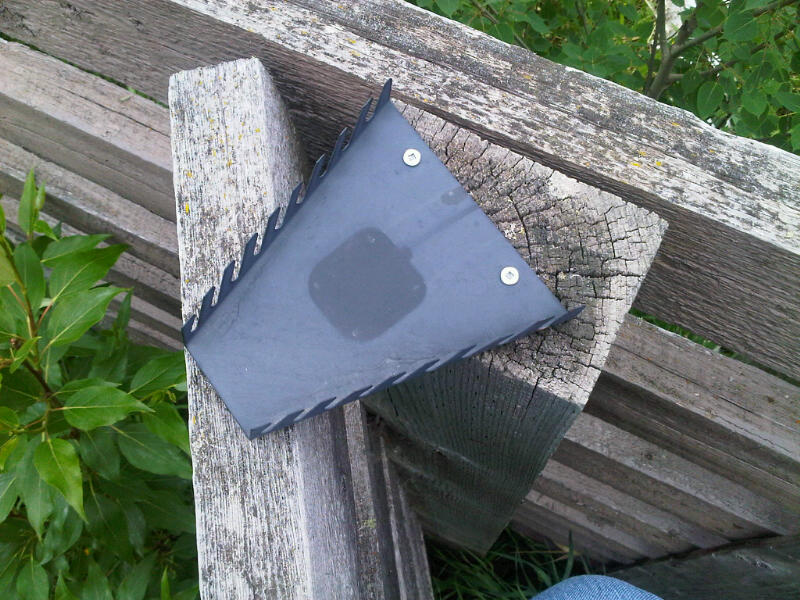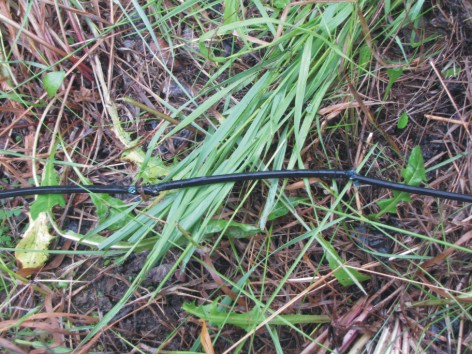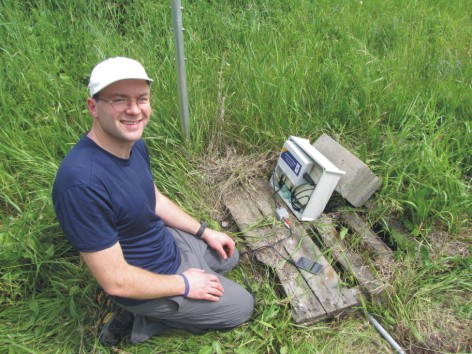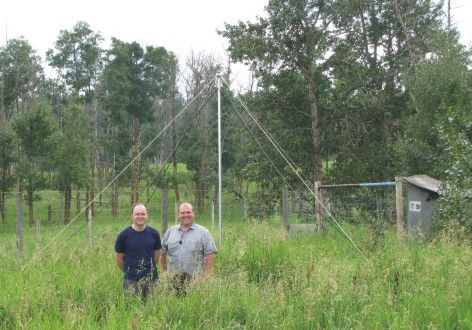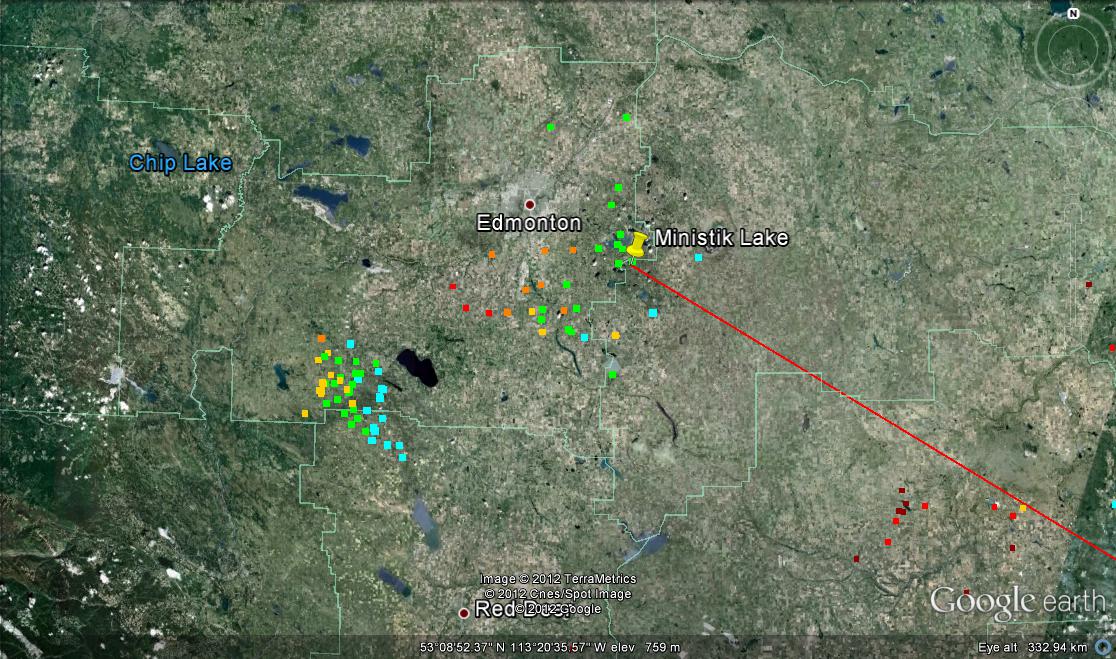Space Side Links
Quick Search
Ministik AARDDVARK repaired in July2012
Ministik AARDDVARK receiver repaired after a hard life!
The AARDDVARK antenna installed at Ministik Lake, Alberta, Canada was installed in October 2010 by Assoc. Prof. Craig J. Rodger (University of Otago) and Dr. Mark Clilverd (British Antarctic Survey). The primary funding for the purchase and deployment for this AARDDVARK receiver was provided by the University of Otago, although it is located at a field site of the Space Physics Group from the University of Alberta. The AARDDVARK antenna is primarily intended to make narrowband observations of powerful VLF communications transmitters, but it also also provides data to the world wide lightning location network, WWLLN.
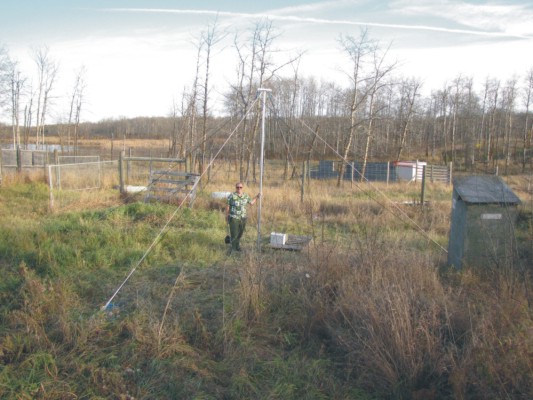 The antenna when originally installed in October 2010.
The antenna when originally installed in October 2010.
Computer problems
Unfortunately, the Ministik Lake AARDDVARK station has had a lot of problems. First of all, disk errors caused the computer which logs the AARDDVARK data to be unstable - locking up or failing to collect data. Eventually, it stopped responding atall. When Dr Dave Milling (University of Alberta) skied out to check the site, he found the PC would not reboot - so despite the snow, he removed the PC, dragged it out, and brought it back to Edmonton for repairs.
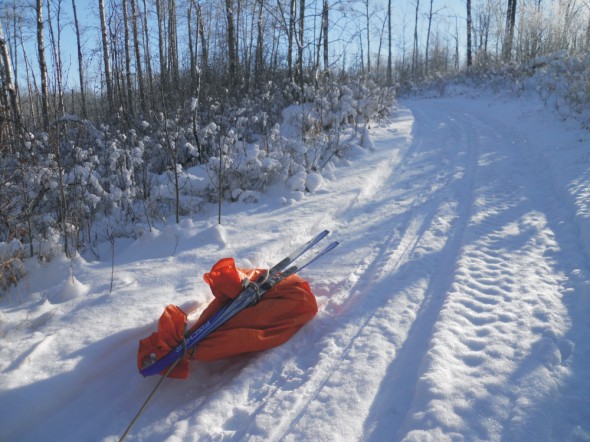 Dave Milling drags the computer out in "the pig" (wrapped in a tarp protected by polystyrene packing).
Dave Milling drags the computer out in "the pig" (wrapped in a tarp protected by polystyrene packing).
Eventually the disk was fixed and the mother board replaced, after which the PC was returned and reinstalled with the Ministik AARDDVARK in mid-2011.
Missing GPS unit
Unfortunately, that did not solve our problems. When the PC was installed the experiment did not work properly, and we found the GPS antenna which should have provided timing information for our experiment was missing!
The cable was snapped off cleanly, although you can see the outline of the GPS antenna sitting on the metal base. We don't know how this happened, but suspect a large creature may have gone by and snagged the wire, ripping it out of the antenna (later on the antenna was found under a long metal cover). So in late June, with the support of the University of Alberta team, we replaced the GPS antenna. The AARDDVARK antenna started logging, but there was clearly something wrong.
Mark Clilverd to the rescue
Dr. Mark Clilverd (British Antarctic Survey) was travelling to Canada, and he headed to Edmonton in mid-October 2011 to try and undertake a quick repair. He replaced our main data cable and we started to get good quality observations!! For a few days. Then the observations on one of the two antenna directions started to look low-amplitude, and within a few days this channel failed entirely. Thankfully, we could get most of our necessary data from the other antenna direction. Which worked until March 2012, after which it also failed.
Otago Team come to do repairs
In July 2012 Dr James Brundell and Assoc. Prof. Craig J. Rodger went to Edmonton to try and bring the AARDDVARK receiver back to life. We quickly found the problem. The main data cable had been bitten through in three locations, cutting off the antenna from the computer, and hence killing the observations.
James and Craig replaced that cable, and then tried to protect it for the future - we placed it all in PVC conduit! This should stop all small creatures trying to bite their way through our cable. We hope. We then calibrated the whole set-up, and the photo below shows James playing calibration signals out of his ipad into the loop.
And finally, we left with what we hope is a repaired AARDDVARK antenna, which will last many more years!
Hopefully, we are now very well positioned to support the upcoming launch of the Radiation Belt Storm Probes (RBSP) by NASA, and the associated BARREL - Balloon Array for RBSP Relativistic Electron Losses campaign planned for the Antarctic. Right now, this instrument is supporting our New Zealand Marsden Fund research project entitled EIEIA.
Craig J. Rodger 19 July 2012.
AND THEN!
Frustration
Yes, the story does not end. At 04:04:52 UT on 5 August 2012, less than 3 weeks after we had repaired the Ministik AARDDVARK the signal suddenly died. The drop was sharp with a 60dB drop in the signal levels. When we looked at data from the World Wide Lightning Location Network (WWLLN) we could immediately see the culprit - a WWLLN detected lightning flash. In fact the WWLLN data shows there were 7 strokes basically right on top of the Ministik Lake antenna site all occurring at 04:04:52 UT!!
WWLLN observations around the time the Ministik AARDDVARK data was lost.
Build it again
It turns out other experiments at the Ministik Lake site were also taken out by the same lightning event, but our AARDDVARK data did not come back, while the others did. Analysis by James indicated that it was most likely that electronics in the VLF preamp had been damaged. And so we built a new one - but first he introduced additional protection! We couriered the new parts to Edmonton.
University of Alberta to the Rescue
On 8 November 2012 (Alberta time) Dr David Milling and Dr. Andy Kale from the Physics Department, University of Alberta, went out to the field site. There had been a recent snow fall, and they had a "nice walk in". But to our huge pleasure they replaced the preamp and the experiment started to work again. So hopefully it will now be stable and we are now very well positioned to support the upcoming launch of the Radiation Belt Storm Probes (RBSP) by NASA, and the associated BARREL - Balloon Array for RBSP Relativistic Electron Losses campaign planned for the Antarctic. Right now, this instrument is supporting our New Zealand Marsden Fund research project entitled EIEIA.
Craig J. Rodger 9 November 2012.


